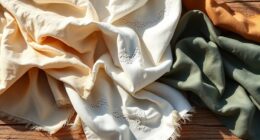Textured walls like grasscloth, plaster, and wood paneling instantly add depth and visual interest to your space. With grasscloth, you get a natural, organic look that’s soft and subtle, while plaster creates a polished, marble-like finish perfect for elegant designs. Wood paneling emphasizes grain and warmth, giving your walls a rich, tactile quality. Exploring these options can transform your rooms into striking, personalized features—keep going to discover how to make these textures work best for your style.
Key Takeaways
- Grasscloth offers a natural, organic texture with subtle color and weave variations, ideal for adding warmth and depth.
- Plaster creates a polished, marble-like finish that can highlight imperfections, suitable for sophisticated, timeless designs.
- Wood paneling emphasizes grain and depth through staining or glazing, providing a warm, textured, and customizable surface.
- Both grasscloth and plaster require proper surface preparation and adhesive application for durable, high-quality results.
- Combining these textures with complementary paint techniques enhances their visual appeal and creates striking interior features.

Textured walls add visual interest and depth to any space, transforming plain surfaces into striking design features. When you choose to incorporate textures like grasscloth, plaster, or wood paneling, you’re adding a tactile element that draws the eye and invites touch. These textures work beautifully with wallpaper patterns and paint techniques, allowing you to craft a unique ambiance that reflects your style. For example, grasscloth offers a natural, organic look with subtle variations in color and weave, creating a warm, inviting atmosphere. Applying wallpaper patterns over textured surfaces can be tricky but rewarding, especially when you select patterns that complement the texture’s organic flow. Use high-quality adhesives designed for textured walls, and consider primer to smooth the surface slightly, guaranteeing your wallpaper adheres well without bubbling or peeling. Additionally, choosing the right wall preparation techniques ensures the longevity and appearance of your finished project. Paint techniques also play a vital role in enhancing textured walls. You can highlight the natural intricacies of plaster or wood paneling by using matte or satin finishes that absorb light differently, emphasizing the surface’s depth. Techniques like dry brushing or sponging add dimension and character to the wall, especially when paired with bold or subtle color choices. For plaster walls, you might choose a Venetian plaster technique, which creates a polished, marble-like appearance with a luminous finish. This method accentuates the wall’s undulations and imperfections, transforming them into artistic features. With wood paneling, applying a stain or glaze can deepen the grain’s visual impact, making the texture stand out even more. If you want to incorporate wallpaper patterns onto textured walls, think about using textured or embossed wallpapers that mimic natural materials or geometric shapes. These patterns add layers of complexity and sophistication, especially when applied to plaster or grasscloth surfaces. Before installation, always verify your wall is properly prepared—clean, dry, and lightly sanded if necessary—so the wallpaper or paint adheres evenly. When painting, consider techniques like rag-rolling or color washing to introduce subtle variations that enhance the tactile quality of the surface beneath. In the end, the key to creating stunning textured walls is understanding how different textures interact with your chosen wallpaper patterns and paint techniques. With careful planning and a bit of experimentation, you can turn any bland wall into a fascinating focal point that elevates your entire space. Whether you prefer the rustic charm of wood paneling or the elegant complexity of plaster, textured walls offer endless possibilities for personalized, eye-catching design.
Frequently Asked Questions
How Do Textured Walls Impact Room Acoustics?
Textured walls substantially impact room acoustics by enhancing sound absorption, reducing echoes, and creating a warmer, more inviting atmosphere. They also add visual depth, making your space feel more dynamic and interesting. When you choose textured finishes like grasscloth, plaster, or wood paneling, you’re not only improving sound quality but also elevating your room’s aesthetic appeal, making it more comfortable and visually engaging.
Are Textured Walls Suitable for Humid Environments?
Textured walls like grasscloth, plaster, and wood paneling aren’t ideal for humid environments because they lack moisture resistance and can deteriorate over time. If you want durability, choose materials specifically designed for high humidity, such as sealed or treated surfaces. You might also consider applying protective coatings to improve their moisture resistance, ensuring your textured walls stay looking good and last longer in damp conditions.
What Are the Best Cleaning Methods for Textured Surfaces?
You should dust removal gently with a soft brush or vacuum with a brush attachment to avoid damaging textured surfaces. For stain cleaning, use a damp cloth with mild soap, testing first on a small area. Avoid harsh chemicals, and never scrub aggressively, as this can damage the texture. Regular dust removal and careful stain cleaning keep your textured walls looking their best without harm.
Can Textured Walls Be Painted Over Easily?
Did you know that over 60% of homeowners choose to paint textured walls to refresh their space? You can paint over textured walls easily with proper painting prep. First, clean and prime the surface. If the texture is too pronounced or damaged, consider texture removal before painting for a smoother finish. This ensures better adhesion and a more polished look, making your room feel brand new with minimal effort.
How Do Textures Influence Interior Lighting and Shadows?
Textures markedly influence interior lighting effects and shadow play. When you have textured walls like grasscloth or wood paneling, light interacts differently, creating dynamic shadows and highlights. This enhances depth and visual interest in your space. You’ll notice more intricate shadow patterns as light hits uneven surfaces, adding warmth and character. Proper lighting placement can accentuate these textures, making your interior feel more inviting and lively.
Conclusion
While textured walls might seem high-maintenance or outdated, they actually add warmth and character to your space. With proper care, like gentle cleaning and occasional touch-ups, they stay stunning for years. Don’t let concerns about upkeep hold you back—embracing textures like grasscloth, plaster, or wood paneling can transform your home into a stylish, inviting haven. Give textured walls a try, and enjoy a unique, sophisticated look that’s worth the little extra effort.










